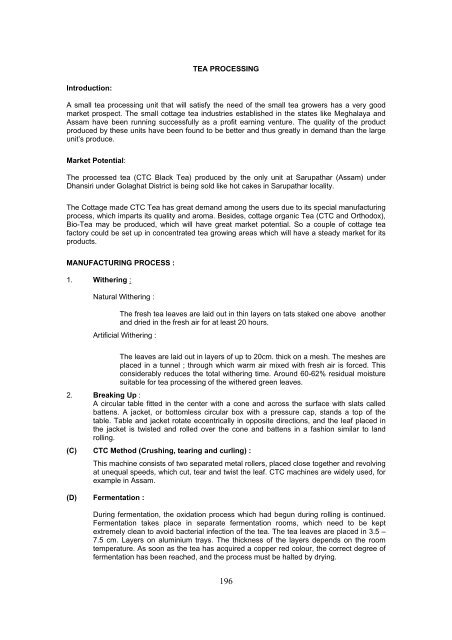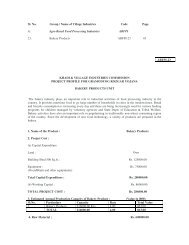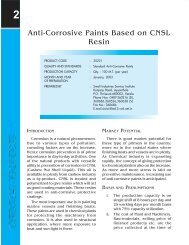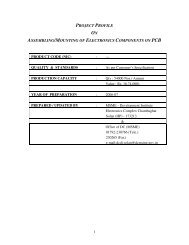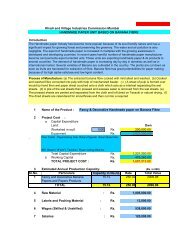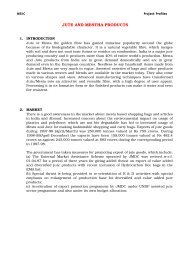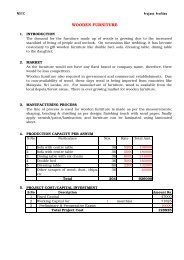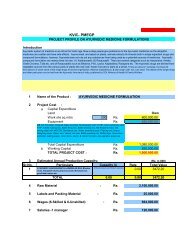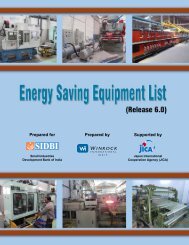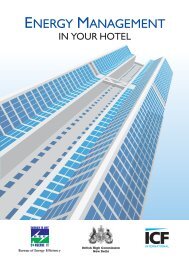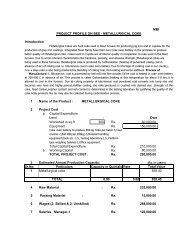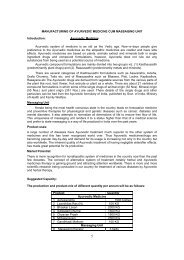TEA PROCESSING Introduction: A small tea processing ... - smallB
TEA PROCESSING Introduction: A small tea processing ... - smallB
TEA PROCESSING Introduction: A small tea processing ... - smallB
You also want an ePaper? Increase the reach of your titles
YUMPU automatically turns print PDFs into web optimized ePapers that Google loves.
<strong>TEA</strong> <strong>PROCESSING</strong><br />
<strong>Introduction</strong>:<br />
A <strong>small</strong> <strong>tea</strong> <strong>processing</strong> unit that will satisfy the need of the <strong>small</strong> <strong>tea</strong> growers has a very good<br />
market prospect. The <strong>small</strong> cottage <strong>tea</strong> industries established in the states like Meghalaya and<br />
Assam have been running successfully as a profit earning venture. The quality of the product<br />
produced by these units have been found to be better and thus greatly in demand than the large<br />
unit’s produce.<br />
Market Potential:<br />
The processed <strong>tea</strong> (CTC Black Tea) produced by the only unit at Sarupathar (Assam) under<br />
Dhansiri under Golaghat District is being sold like hot cakes in Sarupathar locality.<br />
The Cottage made CTC Tea has great demand among the users due to its special manufacturing<br />
process, which imparts its quality and aroma. Besides, cottage organic Tea (CTC and Orthodox),<br />
Bio-Tea may be produced, which will have great market potential. So a couple of cottage <strong>tea</strong><br />
factory could be set up in concentrated <strong>tea</strong> growing areas which will have a s<strong>tea</strong>dy market for its<br />
products.<br />
MANUFACTURING PROCESS :<br />
1. Withering :<br />
Natural Withering :<br />
The fresh <strong>tea</strong> leaves are laid out in thin layers on tats staked one above another<br />
and dried in the fresh air for at least 20 hours.<br />
Artificial Withering :<br />
The leaves are laid out in layers of up to 20cm. thick on a mesh. The meshes are<br />
placed in a tunnel ; through which warm air mixed with fresh air is forced. This<br />
considerably reduces the total withering time. Around 60-62% residual moisture<br />
suitable for <strong>tea</strong> <strong>processing</strong> of the withered green leaves.<br />
2. Breaking Up :<br />
A circular table fitted in the center with a cone and across the surface with slats called<br />
battens. A jacket, or bottomless circular box with a pressure cap, stands a top of the<br />
table. Table and jacket rotate eccentrically in opposite directions, and the leaf placed in<br />
the jacket is twisted and rolled over the cone and battens in a fashion similar to land<br />
rolling.<br />
(C) CTC Method (Crushing, <strong>tea</strong>ring and curling) :<br />
This machine consists of two separated metal rollers, placed close together and revolving<br />
at unequal speeds, which cut, <strong>tea</strong>r and twist the leaf. CTC machines are widely used, for<br />
example in Assam.<br />
(D) Fermentation :<br />
During fermentation, the oxidation process which had begun during rolling is continued.<br />
Fermentation takes place in separate fermentation rooms, which need to be kept<br />
extremely clean to avoid bacterial infection of the <strong>tea</strong>. The <strong>tea</strong> leaves are placed in 3.5 –<br />
7.5 cm. Layers on aluminium trays. The thickness of the layers depends on the room<br />
temperature. As soon as the <strong>tea</strong> has acquired a copper red colour, the correct degree of<br />
fermentation has been reached, and the process must be halted by drying.<br />
196
Drying :<br />
The drying process carried on a 4 plates system vanician typed drier.Hot air up to 90<br />
degree C. is blown against the leaves, which should have reached 80- degree C. by the<br />
time drying has been completed, in order for the polyphenol oxidize enzyme to be<br />
properly inactivated. The moisture content should be reduced to 3.5% whereby the<br />
aroma becomes established and the leaves take on their typical black coloration.<br />
MACHINERY :<br />
Plant & Machinery :<br />
(a) CTC Machine (3CUT) 3 Pair 8” Roller (8-10-8 TPI)<br />
with 3 HP motor complete.<br />
(b) Furnace including heat exchange & Chimney.<br />
(c) Drier (VaniceanType)<br />
includes Blower with 1 HP motor.<br />
(d) Humidifier.<br />
(e) Pivot Balance.<br />
(f) Spring Balance.<br />
(g) Rolling Table-30 kg. batch (with 1 HP motor).<br />
(h) 12.5 KVA Diesel Generator set.<br />
Forced Green Leaves de-humidification Chamber,<br />
Capacity 600 green leaves holding<br />
(j) Fiber Separator.<br />
Total :<br />
SUGGESTED CAPACITY:<br />
Rs. 8.40 lakhs.<br />
600 kg/day for 200 days working days in a year because <strong>tea</strong> leaves are grown seasonally.<br />
Number of shift per day is one.<br />
INFRASTRUCTURE :<br />
The major infrastructure requirements are :<br />
LOCATIONS:<br />
Building 2000 sq.ft.<br />
Power<br />
20 KW<br />
Water<br />
200 litres/day.<br />
This unit can be set up at any <strong>tea</strong> growing areas or where green leaves are available readily, in<br />
NER including Sikkim.<br />
TOTAL CAPITAL REQUIREMENT :<br />
The project cost comprising fixed capital and margin money on working capital is Rs 16.82<br />
lakhs.<br />
Rs. Lakhs.<br />
Fixed Capital :<br />
Land & Building 5.50<br />
Plant & Equipments 8.40<br />
Misc. Fixed Assets. 1.20<br />
Preliminary & Pre-op.expenses. 0.70<br />
Total (A) : 15.80<br />
197
Working Capital :<br />
Raw materials 2 months. 2.27<br />
Finished goods. 1 week. 0.56<br />
Working expenses 1 month 0.24<br />
Receivables 7 days. 1.02<br />
Total-(B) : 4.09<br />
Note :<br />
Working capital may be financed as –<br />
Bank finance : Rs. 3.07 lakhs.<br />
Margin Money : Rs. 1.02 lakhs.<br />
Total<br />
Rs 4.09 lakhs<br />
MEANS OF FINANCING :<br />
The project cost of Rs 16.82 lakhs may be financed as under –<br />
Rs. Lakhs<br />
Promoter’s contribution(35%) 5.89<br />
Term loan(65%) 10.93<br />
Total : 16.82<br />
OPERATING EXPENSES :<br />
The annual operating expenses are estimated at Rs.16.24 lakhs as under :<br />
Rs. Lakhs<br />
Raw materials – 1,20,000 Kgs<br />
Green leaves @ Rs 8/- per Kg. 9.60<br />
Utilities 0.86<br />
Wages & salaries 2.00<br />
Other overheads 0.24<br />
Selling expenses @ 5% on annual<br />
Sales. 1.02<br />
Interest 1.68<br />
Depreciation-10% 0.84<br />
Total : 16.24<br />
SALES REALISATION :<br />
Sl.No. Particulars Amount in<br />
lakhs<br />
1. Green leaves <strong>processing</strong> per year<br />
= 600 kg. per day x 200 days<br />
= 1,20,000 kg. of leaves.<br />
= Total Production of Made Tea<br />
@ 20% yield.<br />
20.40<br />
= 24000 Kg of Made Tea x @ Rs.85/Kg<br />
PROFITABILITY :<br />
Based on the sales realization and the operating expenses, the profit at 100% capacity utilization<br />
would be Rs 4.16 lakhs per year. This works out to a return on investment of 25%. The unit would<br />
break even at about 58% of the rated capacity.<br />
198
HIGHLIGHTS :<br />
The major highlights of the project are as follows :<br />
Total capital requirement : Rs 16.82 lakhs.<br />
Promoter’s contribution : Rs 5.89 lakhs<br />
Annual sales realization : Rs 20.40 lakhs<br />
Annual operating expenses : Rs 16.24 lakhs<br />
Annual profit (Pre-tax) : Rs 4.16 lakhs<br />
Pre-tax return on sales. : 20%<br />
Break-Even Point. : 58%<br />
No. of persons employed. : 10<br />
MACHINERY SUPPLIER :<br />
M/s Avery India Ltd.<br />
12 B, Russel Street,<br />
P.Box – 9329<br />
Kolkata – 700 071.<br />
M/s Bansal Engg. & Steel Co. Pvt. Ltd.,<br />
Rotary Road,<br />
Dibrugarh,<br />
Assam..<br />
199


